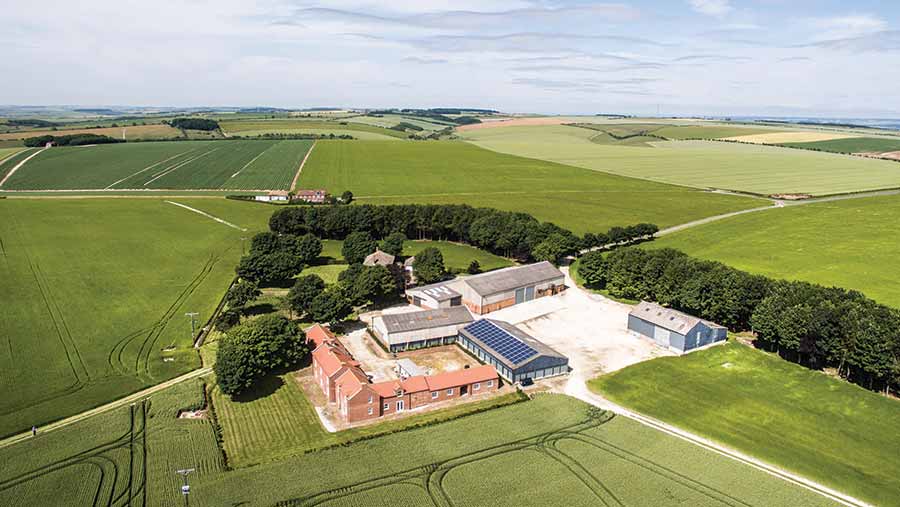Regional outlook: Localised land values paint unpredictable picture in Yorkshire and the Humber
 A 520-acre Wold farm, Danebury Manor came on the market in 2015 and sold through Savills last month.
A 520-acre Wold farm, Danebury Manor came on the market in 2015 and sold through Savills last month. Land values this year in Yorkshire and the Humber are likely to remain difficult to predict, with agents divided over whether supply will be up or down on 2015.
As with most other regions, neighbouring farmers and those with rollover money from development land will have to compete with investment buyers. Holdings with a residential element in good areas are also likely to appeal to non-farmer buyers.
However, low commodity prices are likely to make land less attractive where there is no additional benefit.
In this week’s Farmers Weekly regional outlook, we ask agents in Yorkshire and the Humber to share their thoughts.
Land market values – Yorkshire and the Humber
| 12 month to Dec 2014 | 12 month to Dec 2015 | |
| No of farms publicly advertised nationally | 20 (4,602 acres) | 36 (6,560 acres) |
| Average value – all types of farmland | £6,800 | £6,800 |
| Average value – prime arable farmland | £10,100 | £10,100 |
| Average value – Grade 3 arable farmland | £7,100 | £7,100 |
| Average value – Grade 3 grassland | £5,500 | £5,500 |
Source: Savills
Andrew Dickins, Robin Jessop, Bedale
- The supply of land and farms in the region has been low compared to other years. We marketed a block of 340 acres of bare land which was sold in three lots to investors and a 140-acre dairy farm. Mowbray Hall Farm was guided at £1.50m and achieved over £2m when we sold the property by auction in November. The buyer was from London.
- Bare land in the region is achieving between £7,000/acre and £14,000/acre for good arable land and grassland between £4,000/acre and £8,000/acre.
- In 2015 we saw demand for farmland remain strong throughout North Yorkshire. However, moving forward into 2016 could be a very different picture. The strong pound and low commodity prices continue to put pressure on agricultural incomes.
- We have seen demand increase from investors over the past year and in the future I believe this demand will continue.
- Lifestyle buyers and rollover money from the sale of development land will continue to play an important role in the land and farm market over the course of the next 12 months. Farms situated in good areas with attractive residential appeal will continue to appeal to non-farmers. The smaller blocks of bare land appeal to both investors and farmers who wish to expand their current operations.
Mark Ludiman, Bruton Knowles, Northallerton
- The land market in 2016 will be a mixture of poor supply and very local demand. Purchasers will come out of the woodwork for land they feel they have to buy and vendors will hold on to land as long as they can.
- Rollover money will continue to burn holes in pockets for those lucky enough to have it but commodity prices will make land less attractive where there is no additional benefit.
- There was a flurry of good sales in the middle of 2015 but results have been hardening since then and will continue to provide mixed results well in to 2016.
- The market does not seem to have any consistency in type of land or location and purely seems to be about which neighbours can afford to buy it and I think this will continue in to 2016 and the market will become very cautious indeed.
Andrew Black, Savills, York
- Supply last year was up by 2,000 acres to 12,300 including 6,300 acres of bare land. There were 13 equipped arable holdings and eight grass farms, but only five in total were over 300 acres, which frustrated some purchasers.
- Early indications are that there will be more land for sale this year but this is based on historic lows with supply having halved over the past 25 years.
- Neighbours will continue to look seriously at local opportunities subject to availability of finance while those seeking larger farms are prepared to look nationally and are becoming more particular in terms of their requirements.
- While purchasers may look to buy land cheaper this year, the lack of opportunity to buy locally will, in many places, support values. Premium prices may still be achieved for the best land where competitive interest is generated from cash buyers and those with rollover funds and strengthening house prices will help residential farms.
See more
